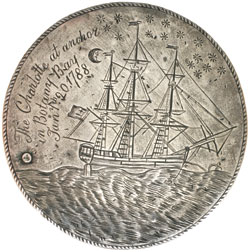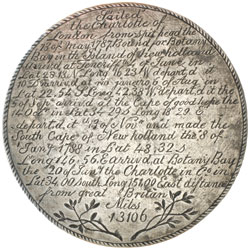Australian Historical Medals (1788-1885)
Lot 704 SESSION 3 (John Chapman Collection, 2.30pm Tuesday) Australian Historical Medals (1788-1885)
Estimate $750,000
Bid at live.noble.com.au
SOLD $750,000
THE `CHARLOTTE' MEDAL, 1788, in silver (74mm, weight 37.58gms) (MH.49 - this piece), engraved on both sides of a thin silver disc, obverse, fully-rigged ship secured to a buoy, sun near horizon to left, crescent moon and stars in the sky, inscribed in left field `The Charlotte at anchor / in Botany Bay / Jany. th 20, / 1788', inscribed on reverse a full description of the voyage from London to Botany Bay (13,106 miles) in nautical terminology. Contemporary in style this medallion was engraved by Thomas Barrett one of the convicts on board the `Charlotte' whilst the ship was anchored in Botany Bay between the 20th and 26th January. This medal is widely acclaimed as the first Australian Colonial work of art and an icon of the foundation of our nation and as such is of immense historical interest to Australia. Extremely fine and unique.
Ex The Marquess of Milford Haven, A.H.F. Baldwin and (Spink Australia Sale 6 [lot 422]) John J.Ford Collections. The `Charlotte' was built on the Thames in 1784. Her length was 105 feet, the maximum breadth between her wales was about 28 feet 2« inches, and her tonnage 38 tons. The ship featured two decks and three masts, but had no embellishments such as a figurehead or galleries, and contemporary records generally describe her as `square-sterned'. She was noted in the official register as `barque-built'. The `Charlotte', along with other ships destined to become First Fleet transports, was chartered by the Admiralty late in 1786 from her owner, a Mr Matthews. She was fitted out at Deptford and in January, 1787, after making her way to Plymouth, embarked with her prisoners. The First Fleet weighed anchor on 13th May, 1787, at the Motherbank in the Channel. It comprised two warships, `Sirius' and `Supply', three storeships, `Borrowdale', `Fishburn' and `Golden Grove' and six convict transports. `Alexander', `Charlotte', `Friendship', `Lady Penrhyn', `Scarborough' and `Prince of Wales'. The `Charlotte' complement consisted of crew, marines (one captain, two lieutenants, two sergeants, three corporals, one drummer and thirty five privates) and convicts (eighty nine male and twenty female). The master of Captain Thomas Gilbert, and the Surgeon, John White. John White was the first Chief Surgeon of the Colony, and a keen sketcher. (Source: Marine Captain Watkin Tench `A Complete Account of Settlement at Port Jackson', London, 1793). The Fleet arrived at Teneriffe, The Canaries, on 3rd June, 1787, by which time `Charlotte' had 15 men on the sick list, one man had already died, and during the stay, a second death occurred. On 10th June the Fleet sailed from Teneriffe and during the crossing of the equator, the `Lady Penhryn', whose crew were busy playing King Neptune, almost collided with `Charlotte'. On 5th August, 1787, the Fleet reached Rio de Janeiro, where it stayed for recuperation until 4th September. After leaving Rio, the Fleet arrived at Cape Town on 13th October, and after a stay, began the final leg of the voyage to Australia on 13th November. The First Fleet finally arrived at Botany Bay on 20th January, 1788, after a somewhat circuitous voyage of 15,063 nautical miles in 184 days of actual sailing time. On 26th January, 1788, the entire First Fleet went around to Port Jackson and anchored there. In early May, 1788 `Charlotte' under charter to The East India Company, sailed for China from whence she shipped a cargo of tea to England. She was then sold to a firm of London merchants, Bond & Co. and began the next stage of her career, the London to Jamaica run. `Charlotte' ended her career under the ownership of John Jones, a merchant in Quebec, Canada. In 1818 she was lost off Newfoundland. (References: Hawkins, J.B., `Nineteenth Century Australian Silver', Woodbridge 1990, Vol 1, page 31, plate 3; article by Dr John M.Chapman 'The Solution of the 'Charlotte' Enigma' in the Journal of the Numismatic Association of Australia, Vol 9, pages 28-33.)
Estimate / sale price does not include buyer's premium (currently 22% including GST) which is added to hammer price. All bids are executed on the understanding that the Terms & Conditions of sale have been read and accepted. For information on grading and estimates please refer to the Buying at Auction advice.
Quick find
View a lot by number and sale.
Adjacent lots
Lot 702
GOLD NUGGET, 301.3gms, clean solid shape no inclusions, found at Kingower, Victoria with a metal ...
Estimate $9,500
Lot 703
GOLD SPECIMEN IN QUARTZ (2), gross weight 38gms, gold content 4gms, gross weight 60.25gms, gold ...
Estimate $900
Lot 704 This lot
THE `CHARLOTTE' MEDAL, 1788, in silver (74mm, weight 37.58gms) (MH.49 - this piece), engraved on ...
Estimate $750,000
Lot 705
THE HALLORAN SCHOOL MEDAL, 1823, in silver (72mm) with loop suspender, by Samuel Clayton, obverse, ...
Estimate $20,000
Lot 706
WESLEYAN SUNDAY SCHOOL, Parramatta, 1825, engraved on the reverse of a three shillings token (1812-1815) ...
Estimate $2,500

